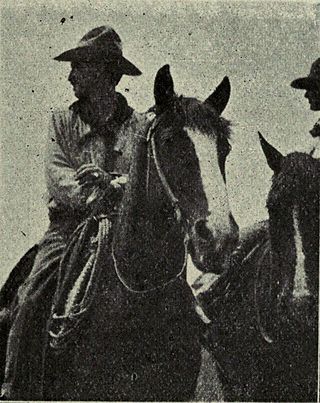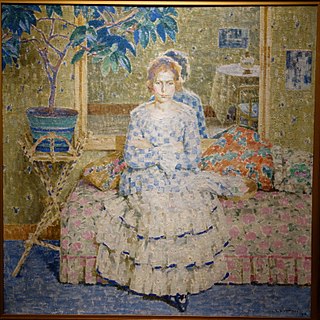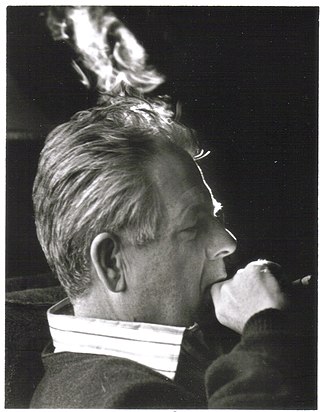
The Taos art colony was an art colony founded in Taos, New Mexico, by artists attracted by the culture of the Taos Pueblo and northern New Mexico. The history of Hispanic craftsmanship in furniture, tin work, and other mediums also played a role in creating a multicultural tradition of art in the area.
Ernest Martin Hennings was an American artist and member of the Taos Society of Artists.

Frederick Carl Frieseke was an American Impressionist painter who spent most of his life as an expatriate in France. An influential member of the Giverny art colony, his paintings often concentrated on various effects of dappled sunlight.

Edgar Alwin Payne was an American painter. He was known as a Western landscape painter and muralist.

Walter Ufer was an American artist based in Taos, New Mexico. His most notable work focuses on scenes of Native American life, particularly of the Pueblo Indians.
Louis Oscar Griffith (1875–1956) was an American painter known for his paintings, etchings, and aquatints of landscapes, especially of scenes in Brown County, Indiana, and Texas. He was born in Newcastle, Indiana in 1875, but five years later moved with his family to Dallas, Texas, where, in his teens, he took art lessons in landscape artist's Frank Reaugh's studio and traveled with Reaugh and other students on sketching exhibitions in West Texas. He then studied at the St. Louis School and Museum of Fine Arts before moving to Chicago in the mid-1890s to study at the Art Institute and work as a commercial artist. After a one-year New York interlude in 1902-03, he returned to Chicago.

John Carl Doemling (1894–1955), artist, the son of Würzburg college professor Leonard Doemling and Johanna Herrmann, was born in Sulzfeld, Rhön-Grabfeld, Bavaria, Germany. Known throughout his life as "Carl", he spent his early years in a seminary preparing to become a priest; however, by age twelve he had opted to pursue an art career instead. He studied art in Würzburg, left home in his teens and supported himself by restoring paintings in churches and monasteries in Italy, Switzerland and France.

Orval Halleck Caldwell was a Chicago-area painter. He was a prolific painter of landscapes in both oil and watercolor.

Soren Emil Carlsen was an American Impressionist painter who emigrated to the United States from Denmark. He became known for his still lifes. Later in his career, Carlsen expanded his range of subjects to include landscapes and seascapes as well.
The Palette and Chisel Academy of Fine Art is a 501(c)(3) non-profit association of representational artists, founded in Chicago in 1895 as the Palette and Chisel Club by a group of students from the School of the Art Institute of Chicago. Palette & Chisel is the second oldest artist organization in the United States.

Joseph Henry Sharp was an American painter and a founding member of the Taos Society of Artists, of which he is considered the "Spiritual Father". Sharp was one of the earliest European-American artists to visit Taos, New Mexico, which he saw in 1893 with artist John Hauser. He painted American Indian portraits and cultural life, as well as Western landscapes. President Theodore Roosevelt commissioned him to paint the portraits of 200 Native American warriors who survived the Battle of the Little Bighorn. While working on this project, Sharp lived on land of the Crow Agency, Montana, where he built Absarokee Hut in 1905. Boosted by his sale of 80 paintings to Phoebe Hearst, Sharp quit teaching and began to paint full-time.
Ruth Van Sickle Ford was an American painter, art teacher, and owner of the Chicago Academy of Fine Arts. She credited artists George Bellows, who influenced her interest in social realism, and John Carlson, who founded the School of Landscape Painting in Woodstock, New York, with helping her to develop her talent. She traveled and made paintings in the United States, Caribbean and South America. An award-winner, her works are in many permanent public and private collections. A book has been written about her entitled Warm Light, Cool Shadows: The Life and Art of Ruth Van Sickle Ford.

William Penhallow Henderson was an American painter, architect, and furniture designer.

Theodore Nikolai Lukits was a Romanian American portrait and landscape painter. His initial fame came from his portraits of glamorous actresses of the silent film era, but since his death, his Asian-inspired works, figures drawn from Hispanic California and pastel landscapes have received greater attention.

Karl Ouren was an American artist best known for his paintings of Norwegian landscapes and scenes, particularly those featuring winter and snow.
Wellington Jarard Reynolds was a well-known Chicago portrait painter and art instructor at the Art Institute of Chicago. Educated in Chicago, Munich, and Paris, he was awarded medals for his work at the Paris Salon as well as in juried exhibitions in the United States.

Louis Ritman (1889–1963) was an American impressionist painter. He is best known for his female nudes, painted in a fashion similar to that of his friends Frederick Carl Frieseke, Lawton S. Parker, and Richard E. Miller, all American artists who studied and lived in France.

David Brewster is an American painter active in the Mid-Atlantic and Northeastern United States.

Richard Earl Thompson was a 20th-century American Impressionist painter who began his career as a commercial illustrator in Chicago, Illinois. In 1959, he broke away from a career as a commercial illustrator, which began in 1933, to pursue Impressionist painting. He was a prolific painter, sometimes compared stylistically to Claude Monet.
Helen Searle, also known under her married name of Helen Searle Pattison, was an American painter of still lifes who was stylistically associated with the Düsseldorf school of painting.














